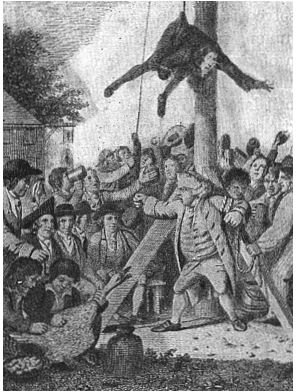Loyalists During the American Revolutionary War: What Happened to Them?
The Loyalists in the Revolutionary War were the American colonists who supported King George III of England and did not want independence. They made up about 20 percent of the population in the colonies. While only about 19,000 of them actually fought in the war, they made the conflict much more bitter by splitting the society into opposing camps. They had a variety of reasons for their opposition to the Revolution and had some tough decisions to make after the war was over.
Who Were the Loyalists?
The Loyalists lived in each of the colonies, in urban and rural areas, and they practiced many different trades. However, some areas and social niches had a greater percentage of Loyalists than others. New York, which the British occupied during the American Revolution, had a heavily British culture and may have been as much as half Loyalist. The Carolinas also had a large Loyalist population, mostly among the rural farmers.
Anyone appointed by the British government tended to support the Crown; successful merchants and Anglican ministers usually favored England as well. Quakers tended to be Loyalist because they were pacifists, and being a revolutionary meant supporting the war. Store owners, farmers and craftsmen were also often Loyalist.
There were a few specific ethnic groups that tended to be Loyalists in the Revolutionary War: Germans favored Britain because of King George III’s German background, and Native and African-Americans alike often supported the British because the Crown had promised to end slavery. Indentured servants often felt the same way.
Why Did the Loyalists Support the Crown?
Aside from these particular ethnic and social reasons to remain loyal to Britain, the Loyalists had economic and political reasons for their affiliation. John Locke’s theories, which supported a limited government, were widely accepted at the time, and acts like the Stamp Act and the Coercive Acts went against these theories. By and large, the Loyalists didn’t approve of these acts any more than the revolutionaries did; however, they were afraid that a revolution would lead to either despotism or anarchy, and they preferred the devil they knew to the devil they didn’t. Also, Britain had a strong, established economy and trading fleet, and the colonies were able to reap the benefits of that system. Severing ties with England would mean supporting themselves entirely as a country, and the Loyalists were concerned that the colonies were not prepared to do that.
What Became of the Loyalists After the War?
Many of the Loyalists had their property confiscated during or right after the war, until the Paris Peace Treaty of 1783, which gave it back to them. The Paris Peace Treaty also gave Loyalists the right to live and work safely in the United States, without fear of retribution for their support for the Crown. Nonetheless, between 60,000 and 80,000 Loyalists chose to leave the new country. Most of them moved to Canada; a group of 1,000 black Loyalists chose to move to Sierra Leone.
While the people who were Loyalist during the Revolution were legally safe and free to remain in the United States, many states prohibited them from working for their governments, and they were hated and mocked by their neighbors who had supported the revolution. The Loyalists in the Revolutionary War survived the change of power, but their association with the British Crown destroyed their reputations and their social standing in the new nation.
Additional Resources
The entire text of the Paris Peace Treaty of 1783 is available at https://studyourhistory.com/studies/original-documents/the-paris-peace-treaty-of-1783.
An index of primary sources about the Loyalists in the American Revolution is available at https://www.royalprovincial.com/index.htm.
References
- United States History - Loyalists During the American Revolution, http://countrystudies.us/united-states/history-33.htm
- Loyalists and Loyalism in the American Revolution, http://hti.osu.edu/history-lesson-plans/united-states-history/loyalists
- Image from The Project Gutenberg EBook of History of the United States by Charles A. Beard and Mary R. Beard, via Wikimedia Commons.
